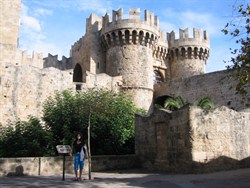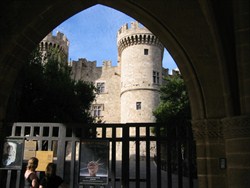Rhodes Town
Situated at the north end of the island, Rhodes Town is a brilliant harmonious blend of old and new offering you two towns for the price of one. The modern island capital has broad three-lined avenues, a splendid array of boutiques, imposing public buildings, and is packed with fancy hotels, smart restaurants and nightclubs that add to its cosmopolitan air. The newer area is also where the shingle beach lies. Right next door, there is the magnificent Old Town (or Medieval Town), a strikingly well-preserved fortress city built by the Knights of St John. Strolling around the narrow cobbled streets and alleyways, alongside the Palace of the Grand Masters (or Castello), it is very easy to picture what the place must have looked like back in the Middle Ages, despite all the modern boutiques, tavernas and fascinating souvenir shops. Whatever your preference, Rhodes Town has it all. Rhodes Town - a captivating, bustling capital, historic, cosmopolitan, romantic...and as lively as you like!
Rhodes Old Town
The Old Town, surrounded by strong imposing walls and with its magnificent fortress built in the 14th century by the Knights of St. John, is today among the largest and most well-preserved medieval settlements in Europe and designated a World Heritage Site by UNESCO. The city was founded in 408 BC when the inhabitants of Ialyssos, Lindos and Kamiros decided to build a powerful new city as the capital of the island. Laid out according to the Hippodameian urban system it was considered one of the most beautiful cities of that period. It quickly evolved into an important economic and cultural center but under the rule of the Romans and later Byzantines dwindled in significance and lost its ancient glory. In 1309 the Knights of St. John took possession of the Byzantine city, extended it and surrounded it with very strong fortifications, transforming it into a thriving multinational medieval city. In 1523 it fell into the hands of the Ottoman Turks and the Greeks who did not leave Rhodes with the Knights were forced to settle outside the old city and its protective walls, creating new neighborhoods in the south called 'Marasia'. They were later joined by people who came from other islands and countries and settled in the northern coast of the island. That is how Rhodes New Town sprang up.

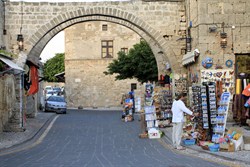
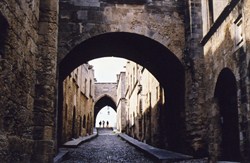
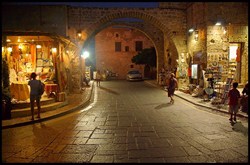
Rhodes Old Town is an exquisite museum of the medieval era, home to a number of sights you shouldn't miss during your visit. The oldest inhabited medieval town in Europe, it is remarkable with its castles, houses and a warren of cobbled squares and alleyways. There are approximately 200 streets and lanes in the Old Town that simply have no name so finding your bearings here is quite a challenge but getting lost may actually be a great opportunity to explore. When in trouble finding your way ask for Sokratous, which is the closest the Old Town of Rhodes comes to having a main street. Sokratous leads to Hippocrates Square (Plateia Ippokratous), the commercial center of Old Town, lined with lots of cafes, bars, restaurants and nightclubs. Strolling around the cobble-paved streets with the majestic buildings of the Knights, the huge walls of the Old Town and the moat, the Byzantine churches and the Ottoman mosques, squares, gardens and courtyards one can get the impression that time came to a halt here.
Encircled by a high defensive wall, the architecture of the Old Town is both daunting and awe-inspiring. There are six main gates leading to the medieval town and a series of smaller ones. You might of course enter through the gate that's closest to where you approach the walls of the Old Town of Rhodes from, we recommend however that you first enter through Eleftheria (Liberty) Gate off Mandraki and from there start your tour. It will lead you to Plateia Symi (Symi square), containing ruins of the Temple of Venus, dating back to the 3rd century B.C., a reminder that a great Hellenistic city once stood here and encompassed the entire area now occupied by the city, including the old and new towns.
The population of the Hellenistic city of Rhodes is thought to have equaled the current population of the whole island (approx. 100,000). At Simi square you will also find the Municipal Art Gallery of Rhodes, above the Museum Reproduction Shop, housing an impressive collection comprising mostly works by prominent modern Greek artists. A little further on is the Museum of Decorative Arts with its finely made objects and crafts from Rhodes as well as other islands (in particular from Symi), a glorious mishmash of ceramics and traditional costumes. Continue through the gate until you reach Ippoton street, also known as the Street of the Knights, one of the best preserved and most delightful medieval relics in the world and the most attractive area of the Old Town containing the most important public and private buildings of the Knights' rule. Walking down the street one nearly hears galloping of horses, while in the half-light of the iron lamp posts one can nearly discern flashing armor of the Knights.
The 600m-long, cobbled street was constructed over an ancient pathway that led in a straight line from the Acropolis of Rhodes to the port. In the early 16th century it became the address for most of the inns of each nation (also known as 'tongues' because of languages that they spoke), which housed Knights who belonged to the Order of St. John. The inns were used as eating clubs and temporary residences for visiting dignitaries, and their facades reflect the various architectural details of their respective countries. Today, of all the inns on the Street of the Knights, only the Inn of France is open to the public.
The other inns are now offices or private residences. Strolling along the street there is a lot to admire. Start at the lowest point on the hill, at Spanish House, now used by a bank. Right next door you will see the Inn of the Order of the Tongue of Italy, constructed in 1519, the Palace of the Villiers of the Isle of Adam, dating from 1521 and housing the Archaeological Service of the Dodecanese. Then comes the Inn of France, one of the most ornate inns built in 1492, now hosting the French Language Institute. Opposite the inns is one side of the Hospital of the Knights (the entrance is on Museum Square),a grand and fascinating structure, now housing the Archaeological Museum.
Across the street there is the Museum of Byzantine Art housed in the 11th century Church of Our Lady of the Castle(the Roman-Catholic Cathedral of the Knights), hosting exhibits of Christian Art. Past the Arch that spans the street is the Inn of the Tongue of Provence and the Inn of the Tongue of Spain, traditionally Gothic with a lovely garden in the back.
The culmination is the largest and finest building of the Old town: the Palace of the Knights, also known as the Palace of the Great Masters (Castello) built at the end of the 7th century by the Byzantines and later converted by the Knights of Rhodes in the 14th century, an imposing and truly incredible fortress with a large courtyard. It was destroyed in a catastrophic accidental explosion in 1856 during the Ottoman rule so what you see before your eyes is a grandiose palace reconstructed in the 1930s to accommodate Mussolini's visits and fantasies, today used primarily as an exhibition centre. Take a walk through its grand halls and chambers with their ancient mosaic floors (stolen from Kos by the Italian military), and antique furniture to feel the atmosphere of the place. From April to October the Palace hosts in its gardens the Municipality of Rhodes light and sound shows (Son et lumière), retelling the Knights' story. The lanes beyond the Knights' Quarter are lined with cafes, restaurants and shops if you care for a break in touring the site of the Old Town. If you walk a couple of blocks south from the Palace of the Great Masters you will reach The Mosque of Suleiman and the public baths, the reminders of the years of Turkish presence on the island of Rhodes.
Be sure not to miss the mosque with its slender minaret and pink-striped Venetian exterior, erected by Suleiman the Magnificent, Sultan of the Ottoman Empire and rebuilt in the 19th century. If you are interested in the vestiges of Turkish culture and are up for some splashing, scrubbing and massaging visit the Municipal Baths, also called by the locals 'Turkish baths' and 'hamam' (Turkish word for 'bath') that are housed in a 7th century Byzantine structure situated in Plateia Arionos between a large old mosque and the Folk Dance Theatre. The Old Town was also home to the Jewish community whose origins date to the days of the ancient Greeks. In the Jewish Quarter, situated in the northeast of Old Town there are still some houses with Hebrew inscriptions, the Jewish cemetery and theSquare of the Jewish Martyrs (Plateia ton Martiron Evreon) also known as Sea Horse Square because of the sea horse fountain that is there.
The square commemorates the 1,604 Jews who were rounded up here and sent to their deaths at Auschwitz. There is a lovely Synagogue in Dosiadou street, right off the square, with a tiny museum attached to it. The Synagogue was built in 1575 and is the oldest functioning synagogue in Greece.When already at the Square, don't miss the opportunity to visit the Hospice of St. Catherine built by the Order of the Knights of St. John in the 14th century to host and entertain esteemed guests. You will find inside exceptionally beautiful sea-pebble and mosaic floors, carved and intricately painted wooden ceilings, a grand hall and lavish bedchamber and engaging exhibits. There is a lot to excite the eyes and the imagination so be sure to call in there when already in the area.
When wandering around the Old Town you may also notice the remains of the inner fortifications that during the rule of the Knights Hospitaller separated the area of Kollakio (or Kollako), which was occupied by the Order, from the rest of the town, called the Burgh or Hora. The Kollakio spanned: the Street of Knights, the Palace of the Grand Masters, the churches of the Order, the Hospital and other edifices, while the Burgh included the old market (Sokratous Street) and Turkish bazaar around the Mosque of Suleiman and other sites. The Burgh was the area for the bourgeois and the Greeks as well as other nationalities residing in the Old Town: Jewish, Turkish and others, each living in their own district.
After touring the sights of the Old Town of Rhodes, you might want to walk around the 4km long walls, which is also a unique experience. The fortification has a series of magnificent gates and towers and is remarkable as an example of a fully intact medieval structure. Much of the structure can be viewed from just walking around the outside but to walk along the top of the huge walls requires admission fee. Also look for the mid-19th century clock tower, which affords a marvellous panoramic view of the Old Town.
Rhodes New Town
When in 1523 Rhodes fell into the hands of the Ottoman Turks the Knights were made to leave the island. The Greeks who did not leave along were forced to settle outside the old city and its protective walls, and built new neighborhoods in the south called 'Marasia'. They were later joined by people who came from other islands and countries and settled in the northern coast of the island. That is how Rhodes New Town came into existence. Today, most of the buildings in the modern part of the town date from the Italian rule over the island (1912-1944). The Italians changed the architectural style of the city with their stately buildings, broad streets and a number of squares. The style is neo-Gothic and Venetian which adds to the charming ambiance of the city and it is also here that plenty of luxurious hotels, cafes, restaurants and shops are located.
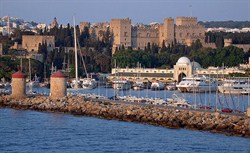

The vibrant New Town of Rhodes is best explored after dark as it houses innumerable bars, discos, nightclubs, as well as tavernas while in the heat of the day Rhodes Town beach is very popular. There are quite a few landmarks in the modern part of the city that are an absolute must-see once here, such as Mandraki Harbour with its marina full of luxury yachts from all over the world. Mandraki harbor was the military port of ancient Rhodes, its 'mouth' (entrance) is now adorned by statues of a male and female deer (Elafos and Elafina), symbols of the island, which stand on columns and are supposed to mark the spot where the Colossus of Rhodes once stood, one of the seven wonders of the ancient world. They were built by the Italians and symbolize the actual deer they brought to Rhodes to rid the island of snakes. Dozens of boats, cruisers, hydrofoils and catamarans depart from Mandraki every day on short cruises to the nearby islands as well as other resorts of Rhodes island.
Apart from Mandraki, Rhodes Town has yet another, larger harbour where the cruise ships and ferries stop.
Apart from the deer statues, Mandraki is distinguished by the three 14th century windmills standing on the breakwater that leads to the tower, being all that remained of a line of 14 medieval windmills which were used to ground wheat, as well as the fortifications at the end of the dock. The 15th century Tower of Saint Nicholas at the end of the pier in the Mandraki harbor was the key to the defense of the city and in both the first unsuccessful siege of 1480 and the second and final one that took place in 1522-23 and was then pounded into rubble in some of the most ferocious battles in the defense of the city.
Across the street from Mandraki there is an impressive complex of New Market (New Agora), a shopping centre housed in a large 7-sided impressive building with gold decoration and round domes, with an outdoor central courtyard where the old fish market was once situated. The front of the market is lined with snack bars and fancy cafes which all seem to have the same identical strawberry sweets and pastries. There is a wide array of shops on the inside and the outside of the building along with a dozen or so grill restaurants, all with whole chickens and cuts of lamb and pork turning on rotisseries day and night. Between the New Market and the entrance to the Medieval Town there is a shaded park area where street vendors sell sponges, shells, beads and jewelry and a line of street artists wait to offer their services to the tourists passing between the two towns.
Another attraction of the New Town is the 'neoimperial' architecture which one can spot along the harbour, dating from the times of Italian occupation. Much of the new city as it is today was built by Mussolini and there is a good number of Art Decco buildings mixed in with modern apartment buildings and neoclassic architecture. Some of the most impressive buildings reminding of the Italian presence on the island now house the Prefecture, the National Theater, the Courts, the Post Office, the City Hall and the Governor's Palace, all located in the same area beyond Eleftherias Square, on the western side of Mandraki harbour. Another draw of the New Town is the lovely Rodini Park situated in the southern part of the city where you can see the famous deer of Rhodes, peacocks living and breeding in the wild, as well as other unique flora and fauna. There is always an ancient burial site in the park if you care for a dash of history.
For more history head for the mountain of Monte Smith (St. Stephen's Hill) with its impressive remains of the ancient Acropolis of Rhodes atop, yet another highlight of the New Town. Situated above the modern city, on top of the north end of the island it offers spectacular panoramic views of the new city and the coast with the sea visible on two sides of the northernmost tip of the island of Rhodes. This is a pleasant site to explore leisurely with a picnic and there's plenty of shade there. The restored stadium dating from the third century BC and small theatre are particularly impressive, as are the remains of the Temple of Pythian Apollo, dominating the hill. Stay for sunset and you will feel the magic of the place. Although just a few pillars and a portion of the architrave still stand, they are provocative and pleasing, giving fodder to the imagination.
The ancient site situated on Monte Smith is actually a relic of an ancient Hellenistic city of Rhodes, the mountain was named after Sir Sydney Smith whose job was to sit on the mountain and watch for Napoleon's fleet in 1802. ('Just sit here for a year and we'll name this mountain after you.' they told him). There is also a fairly decent underground Aquarium in the New Town situated on the northern coast where the Aegean meets the Mediterranean. It's the most important scientific institute of marine life in Greece and one of a kind in the whole country so it's definitely well worth a visit. If you want to get some insight in the religious history of the city visit the Church of the Annunciation, which was originally a Catholic Cathedral, built in the same style as the church of the Knights of St John, opposite the Grand Master's Palace in the old city. Across the broad avenue is the Mourad Reis Mosque with a small Turkish Cemetery surrounding it. If on the other hand you are in a mood for some flutter the modern capital offers a Casino of Rhodes situated in the historic building of the Hotel of the Roses, recently renovated, which was one of the most popular and luxurious hotels in the Mediterranean in the early years of the 20th century.

